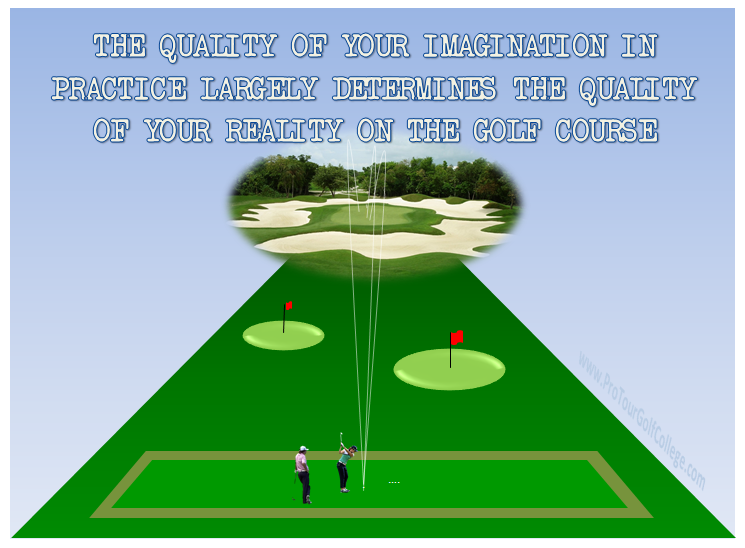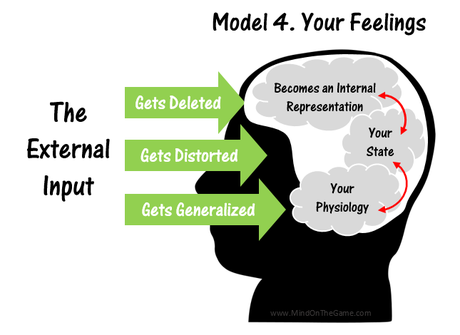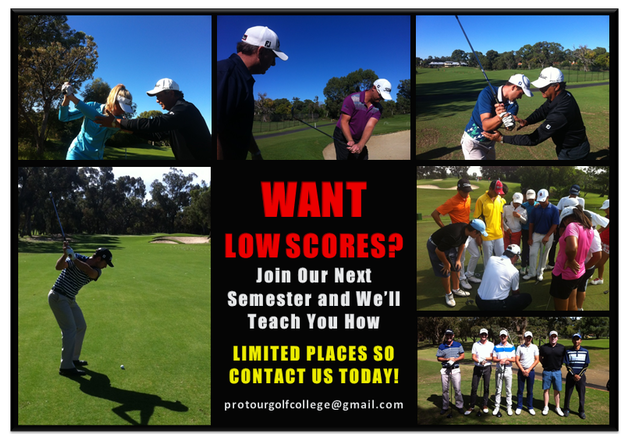"Everyone has his or her own unique map or model of the world, and no one map is any In the past we have discussed the importance of having a personal guiding philosophy to help you define what's important, and what isn't, in terms of how you practice and play golf. We shared with you that in many ways your personal guiding philosophy is like a kind of internal road map or model that you follow to help you get to where you want to go. To expand on this, your perception of the world around you--that's all the 'stuff' that goes on around you we call reality, and the way you represent it to yourself--that's the 'stuff' that goes on inside you, is organised like a unique kind of map. When you are interacting with all this 'stuff' on the golf course and elsewhere, you use your words, which is a language model you use to describe your perception of events taking place. This is how you make sense of the things you interact with in your environment. Therefore, what you specifically say to yourself, and when you say what you say to yourself, depends mostly on the language map you use for the situation at hand. This language map will influence the type of your feelings you have, and also how you behave. So when you compete on a golf course it would make sense to use the best language maps or models right? These models should ideally offer you better choices for playing the right shot at the right time--which would seem to be a lot better situation than having a map that guides you to play the wrong shots at the wrong time--which would not only be influencing higher scores, but also restricting your future choices, resulting in further problems down the track. So, it will be helpful for you to understand the maps and models you use, and realise that you can change any unhelpful or destructive map or model with a more useful one. In this article I'm going to give you a crash course in understanding how to learn aspects of the game faster and better by constructing more effective and useful maps and models. So let’s take a look at how your mental model is constructed by breaking the process down into 5 simple stages, which will help you to positively influence the change process. Stage 1. Come to Your Senses Ok, so you are out on the golf course enjoying your day playing with your friends. As you walk towards your ball eyeing off your second shot on the straight-away par four you're playing, you can see the flag flapping from left-to-right in the wind on the green about 130 yards from you. As you approach your ball, you become aware that you can feel the cool breeze tugging gently at your left shirt sleeve whilst at the same time you notice the smell of freshly cut grass from the greens mower that drives past you 20 yards away. You also just became aware of the taste of that ripe banana you are munching on as you hear your playing partner call out to you "it’s your shot." You see, you are involving all your senses all the time, as you play golf, although most of the time you are unaware or unconscious of this important process that's taking place. It is my goal for you to come to your senses to change this lack of awareness, so that you not only become more aware of your sensory experience, but that you value it highly, relying less on your hallucinations that many times get you into trouble on the golf course. Your sensory experience is the main way you obtain new information about your reality, and yes you add some of this sensory experience to existing mental models and maps, and you also create new ones as well. It will be helpful for you to think of sensory experience as the raw material you use to construct your maps of reality. These 5 senses tune you into your environment, help you to make sense of it with the use of your language, so you can manage what you do in it. Language is a process of free creation; its laws and principles are fixed, but the manner in which the principles of generation are used is free and infinitely varied. Even the interpretation and use of words involves a process of free creation. Stage 2. Your Filters Now as you go to play your golf shot several important and natural processes are taking place. Since there is just way too much information--which is the raw material of reality for your brain to handle at any given moment, your brain has a very clever reality filtering system that slices and dices the information up, coming in from around you through your five senses. Filter 1. Deletion Much of the information coming in is deleted, freeing up your mental hard drive so it doesn't take up space that it needs for storing more important experience. In other words, there's a lot of stuff going on around you all the time that you'll never know about, unless you tune into it, by focusing on it, in which case you will selectively filter it for its usefulness. Filter 2. Distortion The other thing that is happening to the information coming in through your senses is that some of it is distorted—which means that you might use your creative ability to imagine the shape or curvature of the shot, even change the color and content of the landscape, or the shape and dimension of the images. You can even add elements to the landscape that weren't there, or change the content completely. That's one pretty powerful filter! Keep in mind though that many golfers don;t understand the potential of this amazing creative filtering ability (our imagination). However, when you use your imagination properly, you can literally change any and every aspect of your performance on the golf course by filtering content in a more useful and productive way. Filter 3. Generalization Since many of the experiences you have on the golf course are similar in nature, your brain generalizes one experience to next so you don’t have to keep learning the same (or similar) lessons over and over. Think about opening a front door for instance. If you can open one front door, you can apply the same rules to open many front doors. If you can putt on one green, then you can put on any green. If you can hit a drive down the middle of one fairway, you can hit it down many. You can do this not just because it is a habit, but also because you have generalized an experience so that in the case of the putting experience, applying a given a set of rules means that you can putt on any green anywhere. So, when we generalize experience, it helps us to establish consistent rules and routines from context to context that helps us to cope more effectively, and learn more effectively, to make progress in our world. Now Be Careful What You Generalize About... Can generalizing become a problem for us? Yes it can. Let me give you an example. I'm sure you will agree that it will be useful for us to generalize from the experience of being hit by a golfer swinging a golf club on a driving range, because we were too close to them, to a rule that you should never stand too close to any golfer, when they are swinging at a driving range? This would be a useful generalization (rule) right? Getting hit once is definitely enough to create a rule. You don't need to test the theory out more than once. But what if you were to generalize this dangerous experience to a perception that all golfers swinging golf clubs at all driving ranges are dangerous, and that you should never step foot onto any driving range for fear of being hit? This level of generalization would be limiting yourself unnecessarily wouldn't it? After all, you can safely go to any driving range without fearing that you will be hit by a golf club. People with phobia's tend to take an experience and add a set of rules that turns something into an extreme generalization. This reduces their choices greatly, and restricts their lifestyle--which can also impact on their health too.  Do golfers have phobias? Yes, some do, but more often than not they simply develop a fear associated with playing certain shots on the golf course. You would be surprised how many golfers generalize all types of experiences around the learning and playing of golf, which restricts them from making progress on their game. Here's another example, but from outside golf. We have all had the experience of being burned by touching a hot stove (or something on it), and you learn quickly that you will not do it again (again, a good rule to follow). Getting burned and representing it as something to simply avoid is much better than representing it as a life and death moment that leads to you never going into any kitchen ever again. Generalising the experience the right way means that you can go into any kitchen (or on any putting green), cook and prepare a meal without the fear of being burned. That reminds me of a quote from Mark Twain that clearly explains this... “We should be careful to get out of an experience only the wisdom that is in it and stop there lest we be like the cat that sits down on a hot stove lid. She will never sit down on a hot stove lid again and that is well but also she will never sit down on a cold one anymore.” - Mark Twain Model 3. Your Programs Ok, so these three filters are a BIG deal to golfers, and they have a huge influence on the information you encode into your memory, like your beliefs and attitudes etc. This stored information then acts like a kind of program that can be triggered by a certain stimulus or switch--which for instance might turn on an internal dialogue of self-talk that communicates to you that playing this shot from this place is not possible. Conversely, it might trigger a belief that you are very good at this shot, and that the likelyhood of it finishing close to the flag is almost certain. These 'programs' and are mostly unconscious programs which repeatedly filter your experience, guide and direct your thoughts towards different types of shots you wish to play from situation to situation.They run in the background 24/7 and in many ways are like psychological shortcuts that guide your choices, actions, activities and exchanges on and off the golf course quickly and efficiently. They are internal representations (think re-presentation) of your external experience (your reality) that come into your mind through your external senses and govern how your brain pays attention, as well as what it pays attention to. In many ways, it’s like a type of pattern recognition, where your brain sorts the experience from your senses, classifies it, and then runs a program that is useful or helpful to you in some way--or not.  Model 4. Your Feelings The golf shots you produce on the golf course essentially start with you being presented with information from the outside world through your 5 senses, which, with the assitance of your 3 filters, is transformed into a feeling of how to play the shot. This is YOUR way of playing golf. (Read that again slowly) In other words, you take the information from the golf course in through your senses, make an internal representation of it into a map or model that consists of pictures, sounds, feelings, tastes, smells and/or self-talk. From here you move on to generating some type of behavior or action that either moves you in the direction of what you are want, or, moves you away from it. These internal representations often display themselves to you as thoughts or feelings. This all happens in miliseconds. Now these internal thoughts or feelings you generate affect your whole body, influencing the way you hold or compose yourself in different contexts. This is called your physiology. Model 5. Your Behaviour This physiology affects the way that you feel in the moment, which is described as your state. Your state as it is referred to here, means your emotional state, such as; an excited state, a frustrated state, a motivated state, an angry state, a relaxed state, and so on. Now here’s what you must remember about this important process. I want you to think of these 'states' as I have mentioned as your mental strategies or programs that help you to move towards something, or away from something. In other words, they become an action or behaviour that either helps you accomplish a task such as generating a skill like hitting a relatively short putt into a hole, or, they can generate an experience that creates a fear response which leads you to missing that relatively short putt. Now because there's a cause and effect relationship involved in playing golf shots, you are offered a short space of time to recognise your thoughts and feelings prior to, and after the shot, to respond in a useful way. We are talking about a time gap of no more than a second or two. There are many states that you go quickly into and out of throughout the day and the words you use to describe your state are not the state itself but your best choice of words to describe how you feel in that moment. Words will never adequately describe the experience you are having, because words are not the reality, they are just a representation of it.
Think about it like this; the menu is not the meal...The menu simply describes the food available at the restaurant, but not the experience of eating the food, which is totally different. So, it will be helpful for you to learn how to carefully manage the information coming into your mind through your 5 senses and how this information is translated into your behaviour. The words you use to describe a shot for example, can and will change your state, so be mindful of your responsibility to choose words that allow you to make better choices before you hit a shot, or, after your shot has been played. Therefore, your primary goal as a golfer should be to build a better language model and use words that are more positive and specific to the particular context, to get you into an optimal state before you hit each and every golf shot. Your key to unlocking more of your potential lies in using your language more effectively so you can access better and more useful states that help you produce behavior that generates the right shot at the right time. Lawrie Montague and David Milne - Pro Tour Golf College The Professional Golf Tour Training College for Serious Amateur Golfers Recommended Reading: Sleight of Mouth - The Magic of Conversational Belief Change, by Robert Dilts, 1992. Patterns of the Hypnotic Techniques of Milton H. Erickson, Vol 1 by Richard Bandler, John Grinder, 1975. Frogs into Princes by John Grinder, Richard Bandler, 1979. Introducing Neuro-Linguistic Programming by Joseph O'Connor, John Seymour, 1991. The Structure of Magic, Volume I by Richard Bandler, John Grinder, 1975. Trance-Formations by John Grinder, Richard Bandler, 1981. Comments are closed.
|
Archives
June 2019
|
Proudly Supported By
Copyright © 2011 - 2018 Pro Tour Golf College
Website Managed By Golf Performance Media
All Rights Reserved
Website Managed By Golf Performance Media
All Rights Reserved













 RSS Feed
RSS Feed



